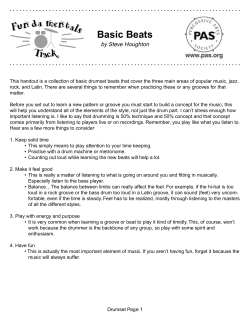
Basics of How to Read Music
Basics of How to Read Music Compliments of Mr. Jody Marvin www.learnitonlinetoday.com Staff Lines Key Signature Measure H Treble Cleff Bar Lines Time Signature Bass Cleff H The treble clef contains notes that are higher sounds than the bass clef, and the bass clef contains notes that are lower sounds than the treble clef. For example, trumpet music is written in treble cleff and tuba music is written in bass cleff. The piano has such a wide range of low and high notes, so you will see these two sets of staff lines combined as in the picture above and below. Note Names C D E F G A B C D E F The Same Note Middle G A B C D G A B Whole Step E F C D E G A B C F G A B C D E F G A B C D E F Half Step Every piano key in order, white or black, on the keyboard is a 1/2 (half) step. Going from one note to another may require a 1/2 step or a whole step. For example, when going from G to A, it is a whole step; G to the black key is 1/2 step, and the black key to A is another 1/2 step. Going from B to C is a half step; there is no note in-between. Knowing about 1/2 steps is important when you play scales and see flats and sharps in music. Rests Notes w h q e s (These are silent beats) =Whole note- lasts four beats. W =Half note- lasts two beats. H Q =Quarter note- lasts one beat. =Whole rest- lasts four beats. =Half rest- lasts two beats. =Quarter rest- lasts one beat. =Eighth note(one flag)- lasts one-half beat. E =Eighth rest(one flag)- lasts one-half beat =Sixteenth note(two flags)- last one-quarter beat. S b B If two or more notes with flags appear in a row, they can be connected with "beams." The number of lines , or “beams,” indicates the note length. n N One beam=Eighth notes Y y Two beams=Sixteenth notes =Sixteenth rest(two flags)- last one-quarter beat. Symbols When used outside of the key signature area, these are called Accidentals. =Flat– play the note 1/2 step lower =Sharp– play the note 1/2 step higher =Natural– Play normal note without a flat or sharp ’ =Breath Mark- place to take a quick breath Time Signature and Rhythm Key Signature (For Major Scales) The time signature tells you how many beats are in each measure and what note will equal one beat. The top number tells how many beats. In this example of four four time, there are 4 beats in each measure. The key signature tells you what notes, in all of the following measures, need to be played a half step higher (sharp) or a half step lower (flat). Each pattern of flats or sharps is named a different key. A large C is another way of saying time. It is called “Common Time.” q q qq = Key of C (also called Open) $ The bottom number tells what note equals one beat. In this example, the 4 tells us each quarter note equals one beat. 2= half note 4= quarter note 8= eighth note In this next example of two two time, each measure has 2 beats and each half note equals 1 beat. A large C with a line is another way of saying time. It is called “Cut Time.” The normal note beats are cut in half. =Key of G =Key of Bb =Key of D =Key of Eb ! d d =Key of F =Key of A =Key of Ab =Key of E Slurring When a group of notes has a line that ties them together, it means to play the notes without tonguing. The beat does not change. =Key of Db =Key of B Putting it all together On the first 3 songs, see if you can write the correct note names and the beats the note gets. Then, play each song. Merrily We Roll Along ’ ‘ Note Names: e __ __ __ __ __ __ __ 1 Beats: __ ‘ __ __ __ ’ __ __ __ __ __ __ __ __ __ __ __ __ __ __ __ __ __ __ Hot Cross Buns ‘ Note Names: Beats: e __ 2 __ __ ’ __ ‘ __ __ __ __ ’ __ __ __ __ __ Scaling It ‘ Note Names: c __ Beats: 1/2 __ __ __ __ __ __ __ __ __ __ __ __ __ __ __ __ __ ’ __ __ Playin’ Around __ __ __ __ __ __ __ __
© Copyright 2025



















